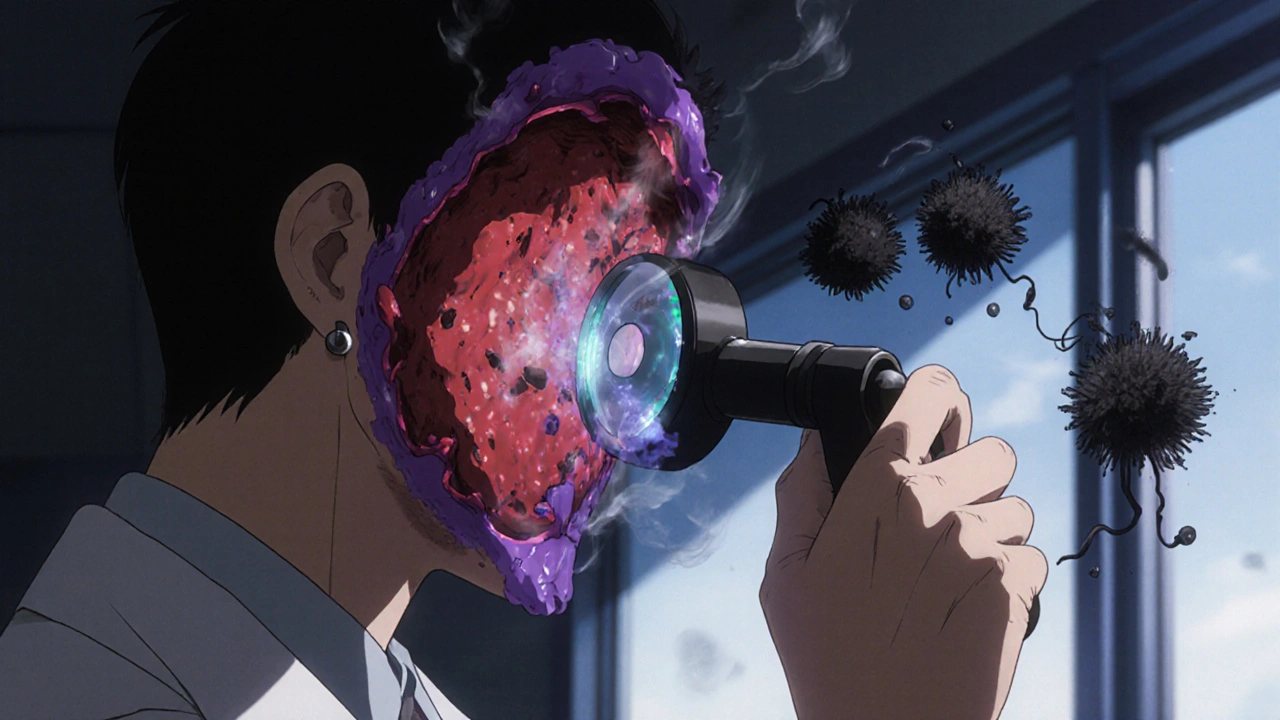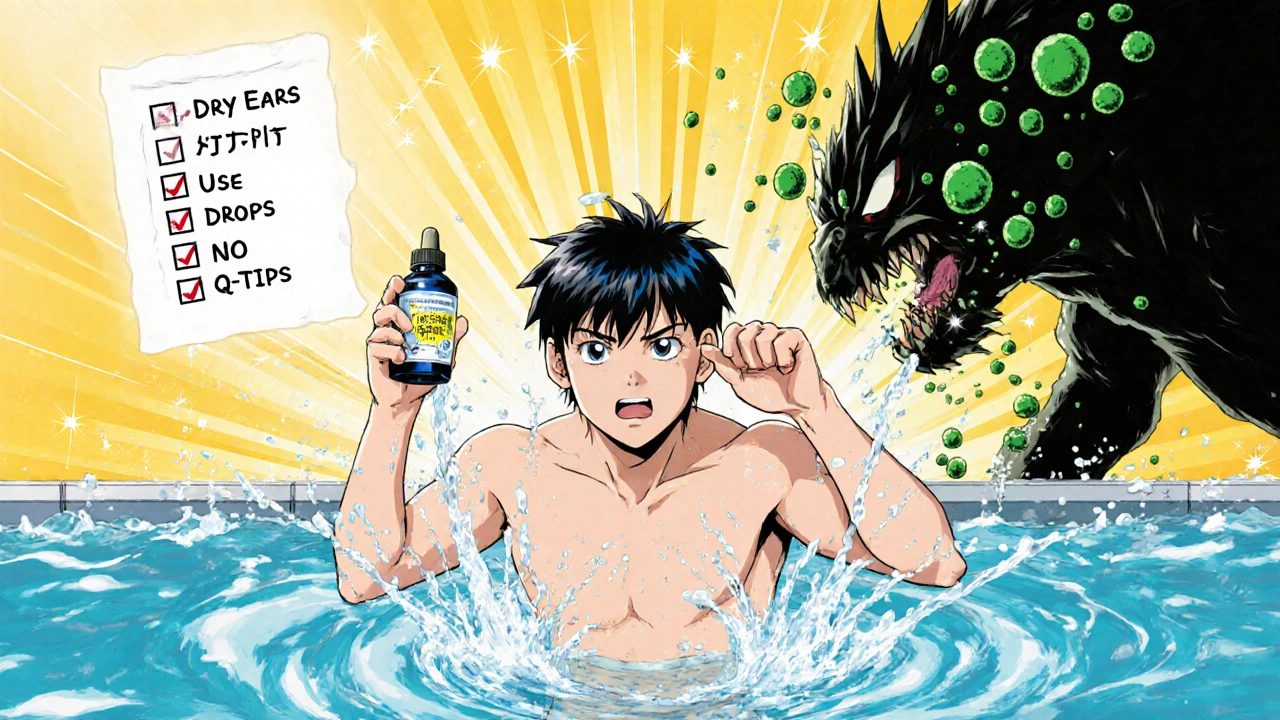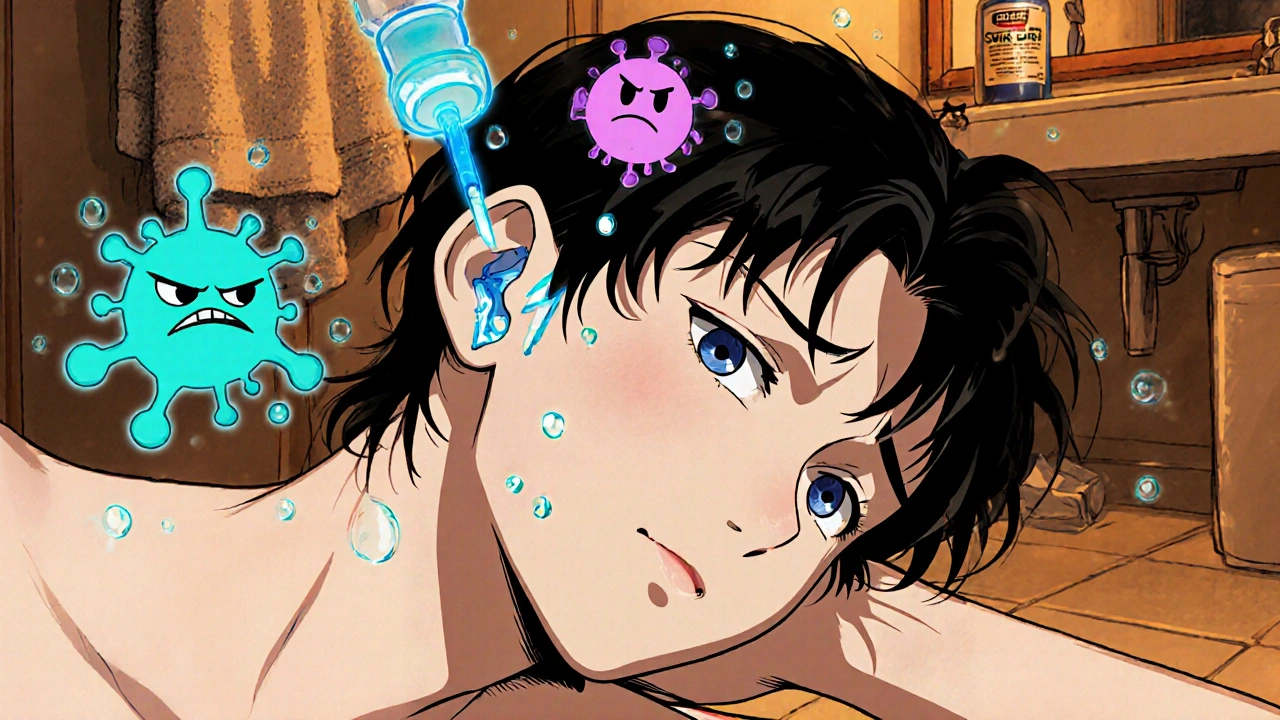Swimmer’s ear isn’t just a nuisance after a day at the pool-it’s a real infection that can turn a simple splash into days of pain, muffled hearing, and even fever. Otitis externa affects the skin lining your outer ear canal, the tube that runs from your eardrum to the outside of your head. Unlike middle ear infections, which happen behind the eardrum, swimmer’s ear is all about the canal itself. It’s not just for kids who love swimming. Adults, especially those with diabetes or who use hearing aids, are just as likely to get it. In the U.S., about 1 in 10 people will deal with it at least once a year, according to CDC estimates from 2022.
What Actually Causes Swimmer’s Ear?
The ear canal isn’t meant to be wet for long. Normally, earwax (cerumen) keeps things dry and acidic, with a pH between 5.0 and 5.7. That acidity is your first line of defense-it stops bacteria and fungi from growing. But when water gets trapped, especially after swimming or showering, that natural barrier breaks down. Moisture softens the skin, letting germs sneak in.
The most common culprits? Pseudomonas aeruginosa, a bacteria found in water, soil, and even showers. It’s responsible for 35-54% of cases. Staphylococcus aureus comes next, causing 20-30%. Less common, but still important, are Proteus vulgaris and Escherichia coli. Fungal infections, called otomycosis, make up about 10% of cases-usually from Aspergillus or Candida species. These thrive in warm, damp environments and often appear as black or white fuzzy growths in the ear canal.
It’s not just water. Using cotton swabs, earbuds, or hearing aids can scratch the delicate skin inside your ear. Even a tiny cut is enough for bacteria to take hold. People with eczema or psoriasis affecting the ear are also at higher risk. And if you have diabetes, your body’s ability to fight infection drops-making otitis externa more likely to turn serious.
How Bad Can It Get? Symptoms by Severity
Not all swimmer’s ear is the same. It comes in three levels, and knowing the difference helps you decide what to do next.
- Mild (45% of cases): Itching, slight redness, and mild discomfort when tugging on your earlobe. You might hear a faint ringing or feel like your ear is full. Pain is usually low.
- Moderate (35%): The ear canal starts swelling, blocking sound. Pain increases, especially when chewing or moving your jaw. Drainage may appear-clear, cloudy, or yellowish. Hearing becomes noticeably muffled.
- Severe (20%): The canal is completely blocked by swelling. Pain is intense, sometimes radiating to your neck or face. You might have a fever over 101°F (38.3°C), swollen lymph nodes, and even trouble opening your mouth. This is when you need to see a doctor immediately.
If left untreated, severe cases can lead to malignant otitis externa, a rare but dangerous infection that spreads to the skull bone. It happens in just 0.03% of cases-but it’s almost always in older adults with diabetes or weakened immune systems. Early treatment stops this from ever happening.
What Drops Actually Work? The Science Behind Treatments
Not all ear drops are created equal. The right one depends on whether your infection is bacterial or fungal, and how bad it is.
For mild cases, the go-to is a simple solution: 2% acetic acid with hydrocortisone. Brands like VoSoL HC Otic are available over the counter. This combo works in two ways: the acid restores the ear’s natural pH, killing bacteria, and the hydrocortisone reduces swelling and itching. Studies show it clears up mild infections in 85% of cases within a week. It’s also great for prevention-using it after swimming cuts recurrence by 65%.
But if your ear is swollen shut or the pain is sharp and constant, you need something stronger. That’s where prescription drops come in. The most effective? Ciprodex (ciprofloxacin 0.3% + dexamethasone 0.1%). This fluoroquinolone antibiotic kills Pseudomonas and Staph, while the steroid reduces swelling fast. FDA trials show 92% of patients are symptom-free in 7 days. Many users on Reddit report pain dropping dramatically within 24 hours.
Other options include ofloxacin (generic versions cost about $45 vs. Ciprodex’s $147.50) and neomycin-polymyxin drops. But here’s the catch: neomycin carries a risk of contact dermatitis in 5-7% of users and can damage your hearing if your eardrum is perforated. That’s why fluoroquinolones like ciprofloxacin are now the standard.
For fungal infections, acetic acid won’t cut it. You need antifungals. Clotrimazole 1% solution works in 93% of cases, according to a 2021 JAMA study. Over-the-counter antifungal drops are rare in the U.S., so you’ll usually need a prescription.

Why Debridement Matters (And Why Most People Skip It)
One of the biggest mistakes people make? Applying drops without cleaning the ear first.
When the canal is swollen, infected debris, wax, and pus build up like a clog. Drops sit on top of it and never reach the infection. That’s why doctors use suction or dry cotton swabs to gently remove the gunk under an otoscope. This step, called debridement, boosts drop effectiveness by 30-40%, according to NIH experts.
But here’s the problem: most people try to clean their ears themselves with cotton swabs. That’s a no-go. Swabs push wax deeper, scrape the skin, and make it worse. Never insert anything into the ear canal-not even a Q-tip. Only a professional should clean it out.
If the canal is too swollen for drops to get through, your doctor may insert a tiny sponge-like ear wick. It’s soaked in medication and expands to open the canal. It’s uncomfortable, yes-but 65% of patients say it’s necessary. You’ll usually remove it yourself after a few days, or your doctor will take it out.
How to Use Ear Drops Right (So They Actually Work)
Even the best drops fail if you use them wrong. Here’s the correct method:
- Wash your hands.
- Warm the bottle in your hands for 1-2 minutes. Cold drops can cause dizziness.
- Lie on your side with the infected ear facing up.
- Hold the dropper above your ear and gently squeeze in the number of drops prescribed.
- Stay on your side for 5 minutes. Gently tug your earlobe to help the drops flow deeper.
- Place a cotton ball at the ear opening to keep the drops in (don’t push it in).
- Don’t clean inside the ear for 24 hours after using drops.
Studies show that 32% of people skip the 5-minute wait, and 28% of OTC users don’t follow instructions at all. That’s why 65% of treatment failures come from poor technique-not bad medicine.

Cost, Accessibility, and New Options
Ciprodex is effective, but expensive-$147.50 without insurance. Generic ofloxacin drops cost about $45 and are nearly as good. Over-the-counter acetic acid solutions like Swim-Ear run just $15 and are great for prevention or mild cases.
In March 2023, the FDA approved a new extended-release version called OtiRx, which works for 24 hours instead of 12. That means fewer doses per day. It’s showing 94% efficacy in trials and may become the new standard soon.
Telemedicine is also changing access. Mayo Clinic’s 2022 pilot study found that 88% of swimmer’s ear cases could be diagnosed accurately via video call. You can show your ear to a doctor, describe your symptoms, and get a prescription without leaving home.
What Not to Do
- Don’t use hydrogen peroxide or alcohol in your ear-they dry out the skin and make things worse.
- Don’t swim until the infection clears. If you must, wear earplugs and dry your ears thoroughly afterward.
- Don’t use leftover antibiotics from a previous infection. You might be treating the wrong bug.
- Don’t ignore worsening symptoms. If you develop fever, swelling in your neck, or trouble moving your jaw, go to urgent care. This could be spreading.
And here’s a big one: don’t assume every earache is swimmer’s ear. Ear pain can come from a tooth infection, jaw problem, or even a foreign object in the ear. If drops don’t help after 2-3 days, see a doctor.
Prevention: Stop It Before It Starts
The best treatment is no treatment. Here’s how to avoid it:
- After swimming or showering, tilt your head to drain water. Gently pull your earlobe in different directions to help it escape.
- Use a hairdryer on low, cool setting, held at least a foot away, to dry your ears.
- Use over-the-counter acetic acid drops (like Swim-Ear) as a preventive rinse after water exposure.
- Avoid cotton swabs, earbuds, or headphones that irritate the canal.
- If you have diabetes or a weakened immune system, be extra cautious-consider preventive drops after every swim.
Swimming is healthy. Ear infections shouldn’t stop you from enjoying it. With the right knowledge, prevention, and treatment, you can keep your ears clear and pain-free.
Can I use hydrogen peroxide to clean my ear if I have swimmer’s ear?
No. Hydrogen peroxide can irritate the already inflamed skin in your ear canal and delay healing. It doesn’t kill the bacteria causing the infection and can make itching and pain worse. Stick to prescribed ear drops or over-the-counter acetic acid solutions designed for otitis externa.
How long does it take for swimmer’s ear drops to work?
Most people feel relief within 24-48 hours, especially with prescription drops like Ciprodex. Pain usually drops significantly by day two. Full healing takes about 7 days, even if symptoms improve faster. Don’t stop using the drops early-finish the full course to prevent recurrence.
Are over-the-counter ear drops enough for swimmer’s ear?
Only for mild cases with itching and minor discomfort. If your ear canal is swollen, you have drainage, or pain is moderate to severe, OTC drops won’t cut it. You need prescription antibiotic-steroid drops. Using the wrong product can delay healing and let the infection worsen.
Can swimmer’s ear cause permanent hearing loss?
Not if treated properly. Temporary muffled hearing is common due to swelling and fluid buildup, but it clears up once the infection resolves. Permanent hearing loss only happens in rare, untreated cases where the infection spreads to the bone or damages the eardrum. That’s why early treatment is critical.
Why do some ear drops sting when I use them?
Stinging is normal with acetic acid solutions and some antibiotic drops, especially if your ear canal is raw or inflamed. The burning usually lasts less than a minute. If it lasts longer, gets worse, or causes swelling, stop using it and see a doctor-you might be allergic or have a fungal infection that needs different treatment.
Is swimmer’s ear contagious?
No. You can’t catch swimmer’s ear from someone else. It’s caused by bacteria or fungi already in your environment-like pool water or shower steam. But sharing earbuds, headphones, or earplugs can transfer germs and increase your risk if your skin is irritated.
Can I use ear drops if I have a perforated eardrum?
Only if your doctor says it’s safe. Aminoglycoside drops like neomycin can be toxic to the inner ear if the eardrum is damaged. Fluoroquinolone drops like ciprofloxacin are safer and often approved for use with perforations, but always check with your provider before using any drops if you’ve had ear surgery or a known perforation.
What should I do if my swimmer’s ear comes back after treatment?
Recurrent swimmer’s ear often means the root cause wasn’t addressed. See an ENT specialist. You might need a culture to identify the exact germ, or your ear canal might have a structural issue trapping water. Also, check if you’re using drops correctly or drying your ears after swimming. Prevention drops after water exposure can help break the cycle.

Christopher Robinson
November 20, 2025 AT 22:52Just used Ciprodex last week after ignoring my ear for 3 days-total game changer. Pain dropped like a rock by day 2. Also, warming the bottle? Genius. Cold drops feel like someone poured liquid nitrogen in there 😅
harenee hanapi
November 22, 2025 AT 04:15Oh my god, I’ve been using hydrogen peroxide for YEARS because my cousin said it ‘cleans everything’-and now I’m paying for it. My ENT called it ‘a war zone’ in there. I’m crying. Why didn’t anyone tell me? 😭
Nick Lesieur
November 23, 2025 AT 02:08So let me get this straight… you pay $150 for drops that work 92% of the time… but $45 generic works almost as good? Sounds like Big Pharma’s latest scam. Also, why does everyone keep saying ‘don’t use Q-tips’ like I’m five? I know, okay? I just like the feeling. 😏
Angela Gutschwager
November 25, 2025 AT 01:13Stop using earbuds. Just stop. You’re not special. Your ears are not exempt. You’re the reason this post exists.
Dion Hetemi
November 25, 2025 AT 02:21Let’s be real-90% of these cases are people who swim in public pools and then act shocked when bacteria thrive in chlorine-water sludge. Also, if you have diabetes and still don’t dry your ears? You’re not a victim. You’re a statistic waiting to happen.
Timothy Reed
November 25, 2025 AT 05:22I’ve been a swim coach for 18 years and have seen hundreds of cases. The #1 mistake? People think it’s just ‘water in the ear.’ It’s not. It’s a full-blown microbiome collapse. The debridement step is non-negotiable. I tell my kids: if your ear feels clogged after swimming, get it checked before it’s screaming at you.
And yes, the ear wick is uncomfortable-but it’s the difference between 10 days of agony and 4 days of relief. I’ve had patients cry from pain, then cry again because they’re finally sleeping. It’s worth it.
Also, OTC drops? Fine for prevention. Not for treatment. Don’t gamble with your hearing. You wouldn’t ignore a broken leg. Don’t ignore a broken ear canal.
Andy Feltus
November 25, 2025 AT 10:55It’s funny how we treat our ears like they’re disposable. We blast them with headphones, jam Q-tips in, swim in chemically treated water, then act surprised when they break. We treat our phones better than our bodies. Maybe the real infection isn’t in the ear canal-it’s in our collective disregard for the tiny, fragile things that let us hear laughter, music, and silence.
Also, if you’re using leftover antibiotics? You’re not being resourceful. You’re being a biological roulette player.
James Ó Nuanáin
November 25, 2025 AT 13:32As a British man who has endured both the Thames and the North Sea, I can confirm: the British NHS would never prescribe Ciprodex. We get a £3.50 bottle of vinegar solution and told to ‘tough it out.’ The Americans pay $147.50 for a cure? How… indulgent. But I suppose, if you can afford it, why not? We still have to wait six weeks for a GP appointment. Meanwhile, you’re already symptom-free. The disparity is… almost poetic.
Kara Binning
November 27, 2025 AT 03:10I’ve had swimmer’s ear THREE times this year. THREE. I use Swim-Ear after every swim. I dry my ears with a hairdryer. I don’t use Q-tips. I don’t swim in public pools. I still got it. Why? Because my ENT says my ear canal is ‘narrow and prone to trapping.’ So now I’m being referred to an ENT surgeon. I’m not lazy. I’m not careless. I’m just… genetically cursed.
And yes, I cried during the wick insertion. I’m not ashamed.
river weiss
November 28, 2025 AT 15:33Important note: Fluoroquinolones (e.g., ciprofloxacin) are now preferred over aminoglycosides (e.g., neomycin) due to ototoxicity risk in the presence of tympanic membrane perforation-this is well-documented in UpToDate and the American Academy of Otolaryngology guidelines, 2023 edition. Always confirm eardrum integrity before use. Also, earwax is not ‘dirt’-it’s a natural antimicrobial barrier. Do not remove unless necessary. And yes-warming the drops is critical; cold liquids trigger vertigo via the caloric reflex. This is basic vestibular physiology.